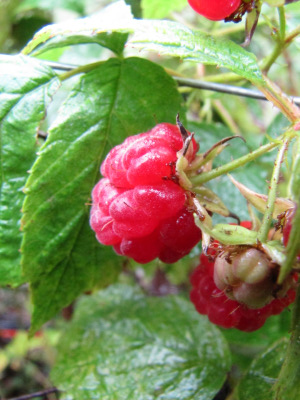
Can you taste good nutrition?
 I've often wondered whether I could taste good nutrition, and I'm
tempted to say the answer is yes. The winter squash highest in nutrients is the butternut --- my favorite. The most nutritious fruits are those grown under a bit of nitrogen stress in the bright sun --- again, my favorites. I vastly prefer the flavor of frozen beans
to canned beans and love to saute, steam, and stir fry. Fresh
fruit is in an entirely different (and better) taste category for me
from any cooked or otherwise processed fruit.
I've often wondered whether I could taste good nutrition, and I'm
tempted to say the answer is yes. The winter squash highest in nutrients is the butternut --- my favorite. The most nutritious fruits are those grown under a bit of nitrogen stress in the bright sun --- again, my favorites. I vastly prefer the flavor of frozen beans
to canned beans and love to saute, steam, and stir fry. Fresh
fruit is in an entirely different (and better) taste category for me
from any cooked or otherwise processed fruit.
Although our bodies get
quickly confused when exposed to fake flavors,
colors, and added salts and sugars, we've clearly evolved some basic
cues for determining which foods are nutritious. In some cases,
natural sugars seem to be the key to the rich taste of fresh,
nutritious food --- higher than usual sugar content in a vegetable can
be a cue that the vegetable is also higher in vitamin C. In other
cases, bright colors hint at higher than ordinary vitamin A --- deep
orange peaches have much higher vitamin A content than white peaches.
Some days, I wish I had
a chemical laboratory in my backyard where I
could test the micronutrient levels of every piece of produce grown in
our garden. Is it really twice as high in nutrition compared to
the grocery store version, just as it is twice as high in flavor?
Without more data to back up my gut feeling, I'll have to assume that
anything that tastes good when I eat it raw is also
good
for me.
| This post is part of our Gardening for Maximum Nutrition lunchtime
series.
Read all of the entries: |
Want more in-depth information? Browse through our books.
Or explore more posts by date or by subject.
About us: Anna Hess and Mark Hamilton spent over a decade living self-sufficiently in the mountains of Virginia before moving north to start over from scratch in the foothills of Ohio. They've experimented with permaculture, no-till gardening, trailersteading, home-based microbusinesses and much more, writing about their adventures in both blogs and books.
Want to be notified when new comments are posted on this page? Click on the RSS button after you add a comment to subscribe to the comment feed, or simply check the box beside "email replies to me" while writing your comment.
